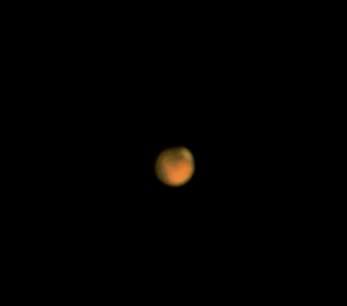I turned my attention to mars. Holy crap, at about 40 degrees off the horizon, seeing was horrid. Mars was an amorphous blob that looked like welder's slag just flickering and changing shapes into many weird oblong patterns. I couldn't even get the image to sit still long enough to get a decent focus. Eyepiece visual viewing was no better, so I popped the imager back in, and shot some .avi's. Only one sequence turned out, and frankly, I am amazed at the detail I got considering the atmospheric turbulence that was present. I could make out the polar ice cap, just barely, and the dark region that I believe was Syrtis Major, although my image is to crappy to be sure. Still, it is my first image of Mars, so here it is...
Sunday, January 15, 2012
First light, Tucsen imager
I was fairly impressed with this new imager. What I wasn't impressed with was my inability to navigate the many settings in the config menu. Seasoned planetary imagers will laugh at this, however it doesn't make it any less frustrating. To make the target bright enough to find for focusing after switching magnifications, you have to over expose the image. Once you find it, you can go back to manual exposure, find a sweet spot, and focus. Problem is that your settings will vary with magnification, and with this much control over the imager, you always flirt on over/under exposure. Such is the problem I had last night. I didn't really get an image of Jove that I am proud of, despite almost a half hour of .avi sequences playing with various exposure schemes and focus tweaks. Again, boring side of Jupiter tonight as the GRS transit was timed perfectly with Jupiter's setting in the western sky where I have all sorts of treeline obscuration.
I turned my attention to mars. Holy crap, at about 40 degrees off the horizon, seeing was horrid. Mars was an amorphous blob that looked like welder's slag just flickering and changing shapes into many weird oblong patterns. I couldn't even get the image to sit still long enough to get a decent focus. Eyepiece visual viewing was no better, so I popped the imager back in, and shot some .avi's. Only one sequence turned out, and frankly, I am amazed at the detail I got considering the atmospheric turbulence that was present. I could make out the polar ice cap, just barely, and the dark region that I believe was Syrtis Major, although my image is to crappy to be sure. Still, it is my first image of Mars, so here it is...
Not bad considering conditions and my inexperience with this imager, but certainly nothing to write home about. Mars presents a very small target, impossible to manually focus, and hard to pin down exposure. Only the ice cap was visible during live stream capture. Jupiter had me spoiled to seeing a large disc at higher magnifications. Even when my scope's alignment was not dead on, Jupiter was forgiving and somewhat easy to find at high mag. Not so with Mars. I will need to find something like a Telrad and use it for dead on location at high magnification. The red dot that celestron includes with my scope is total trash, and I have been using it to get in the ballpark, but that doesn't work for high mag planetary imaging. Focusing was atrocious too, and I now know I need a motorized focuser.
I tried to wait for saturn to rise, but even then I knew that it would be horrible, especially at low elevation. Amospheric color banding at edges was horrible tonight, both imaging and at the eyepiece. I did play around with the moon, but seeing was so bad that a crisp, hard focus was elusive. I was frustrated, cold, and for the first time since I got my scope, dew was forming on the corrector plate. Decided to pack it in for the night. I had seen a hint of what the imager was capable of, so I am cool with that.
I turned my attention to mars. Holy crap, at about 40 degrees off the horizon, seeing was horrid. Mars was an amorphous blob that looked like welder's slag just flickering and changing shapes into many weird oblong patterns. I couldn't even get the image to sit still long enough to get a decent focus. Eyepiece visual viewing was no better, so I popped the imager back in, and shot some .avi's. Only one sequence turned out, and frankly, I am amazed at the detail I got considering the atmospheric turbulence that was present. I could make out the polar ice cap, just barely, and the dark region that I believe was Syrtis Major, although my image is to crappy to be sure. Still, it is my first image of Mars, so here it is...
Subscribe to:
Post Comments (Atom)



No comments:
Post a Comment